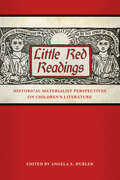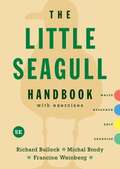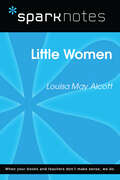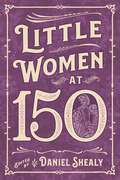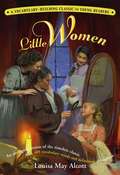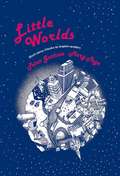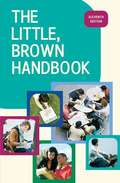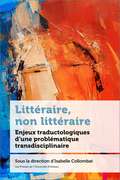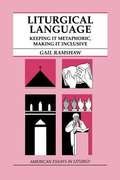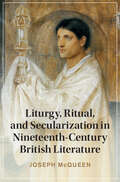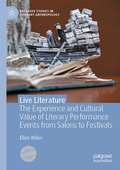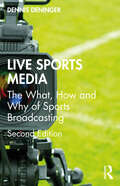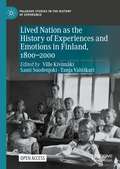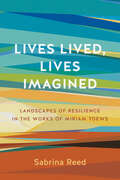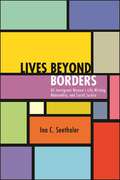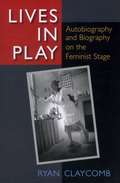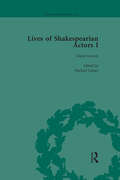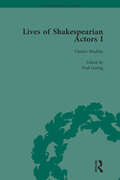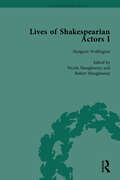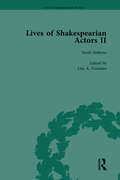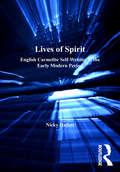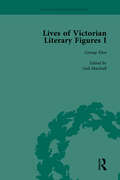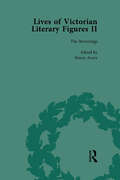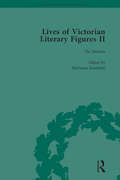- Table View
- List View
Little Red Readings: Historical Materialist Perspectives on Children’s Literature (Children's Literature Association Series)
by Angela E. HublerA significant body of scholarship examines the production of children's literature by women and minorities, as well as the representation of gender, race, and sexuality. But few scholars have previously analyzed class in children's literature. This definitive collection remedies that by defining and exemplifying historical materialist approaches to children's literature. The introduction of Little Red Readings lucidly discusses characteristics of historical materialism, the methodological approach to the study of literature and culture first outlined by Karl Marx, defining key concepts and analyzing factors that have marginalized this tradition, particularly in the United States. The thirteen essays here analyze a wide range of texts—from children's bibles to Mary Poppins to The Hunger Games—using concepts in historical materialism from class struggle to the commodity. Essayists apply the work of Marxist theorists such as Ernst Bloch and Fredric Jameson to children's literature and film. Others examine the work of leftist writers in India, Germany, England, and the United States. The authors argue that historical materialist methodology is critical to the study of children's literature, as children often suffer most from inequality. Some of the critics in this collection reveal the ways that literature for children often functions to naturalize capitalist economic and social relations. Other critics champion literature that reveals to readers the construction of social reality and point to texts that enable an understanding of the role ordinary people might play in creating a more just future. The collection adds substantially to our understanding of the political and class character of children's literature worldwide and contributes to the development of a radical history of children's literature.
Little Seagull Handbook with Exercises
by Richard Bullock Francine Weinberg Michal BrodyWrite. Research. Edit. Everything students need in an affordable handbook they truly use. The Little Seagull Handbook is the #1 best-selling handbook because it’s easy to use, easy to afford, and covers everything students need―no more, no less. Intuitive organization, color coding, and jargon-free instruction for common kinds of writing make it a reference tool that student writers truly rely on. This edition includes new advice designed for developing writers, new advice for using inclusive language, and two new complete model student essays using MLA and APA documentation.
Little Women (SparkNotes Literature Guide Series)
by SparkNotesLittle Women (SparkNotes Literature Guide) by Louisa May Alcott Making the reading experience fun! Created by Harvard students for students everywhere, SparkNotes is a new breed of study guide: smarter, better, faster. Geared to what today's students need to know, SparkNotes provides: *Chapter-by-chapter analysis *Explanations of key themes, motifs, and symbols *A review quiz and essay topicsLively and accessible, these guides are perfect for late-night studying and writing papers
Little Women at 150 (Children's Literature Association Series)
by Daniel ShealyContributions by Beverly Lyon Clark, Christine Doyle, Gregory Eiselein, John Matteson, Joel Myerson, Sandra Harbert Petrulionis, Anne K. Phillips, Daniel Shealy, and Roberta Seelinger Trites As the golden age of children’s literature dawned in America in the mid-1860s, Louisa May Alcott’s Little Women, a work that many scholars view as one of the first realistic novels for young people, soon became a classic. Never out of print, Alcott’s tale of four sisters growing up in nineteenth-century New England has been published in more than fifty countries around the world. Over the century and a half since its publication, the novel has grown into a cherished book for girls and boys alike. Readers as diverse as Carson McCullers, Gloria Steinem, Theodore Roosevelt, Patti Smith, and J. K. Rowling have declared it a favorite. Little Women at 150, a collection of eight original essays by scholars whose research and writings over the past twenty years have helped elevate Alcott’s reputation in the academic community, examines anew the enduring popularity of the novel and explores the myriad complexities of Alcott’s most famous work. Examining key issues about philanthropy, class, feminism, Marxism, Transcendentalism, canon formation, domestic labor, marriage, and Australian literature, Little Women at 150 presents new perspectives on one of the United States’ most enduring novels. A historical and critical introduction discusses the creation and publication of the novel, briefly traces the scholarly critical response, and demonstrates how these new essays show us that Little Women and its illustrations still have riches to reveal to its readers in the twenty-first century.
Little Women: A Kaplan Vocabulary-building Classic For Young Readers (Kaplan Children's Series)
by Louisa May Alcott Kaplan Kaplan Publishing Staff<P><P>Little Women: A Kaplan Vocabulary Building Classic for Young Readers features: <P>*400 vocabulary words to help students aged 9-12 improve their vocabulary while reading classic literature <P>*Glossary of important vocabulary words on the pages facing the text of the story <P>*1 page of discussion questions <P>*1 page of strategies for students to use to learn the meanings of difficult vocabulary words <P>*1 page of tips for writing a book report
Little Worlds: A Collection of Short Stories for the Middle School
by Peter Guthrie Mary PageExplore Little Worlds large collection of stories of high literary quality presenting students with a variety of issues, styles, conflicts, and points of view. Featured authors include Maupassant, Lessing, Hemingway, Welty, Hawthorne and Porter.
Little, Brown Handbook
by Jane E. Aaron H. Ramsey FowlerThe most trusted and authoritative name in handbooks, The Little, Brown Handbook,11/e is an easy-to-use reference that will answer any question you may have in grammar, writing, or research. It also includes exercises so you can practice skills. This edition offers the latest information on writing with computers, writing online, analyzing visuals, and researching effectively on the Internet. With clear explanations, a wealth of examples, and quick reference checklists and boxes, The Little, Brown Handbook will makes it easy to find what you need and use the information you find.
Littéraire, non littéraire: Enjeux traductologiques d’une problématique transdisciplinaire (Regards sur la traduction)
by Isabelle CollombatLittéraire, non littéraire aborde les aires de divergence et de convergence, les différences et les confluences entre le littéraire et le non littéraire dans la perspective d’une application à la traduction et à la traductologie. Cette réflexion épistémologique est alimentée non seulement par l’apport de traductologues, mais aussi par ceux de chercheuses et de chercheurs issus des domaines extérieurs ou connexes à la traductologie et dont cette dernière se nourrit – en l’occurrence, le droit, la lexicologie, la théorie littéraire (narratologie et histoire littéraire) et la philosophie.Le pari de ce collectif est double : d’une part, il cherche à illustrer de manière concrète comment peut fonctionner et évoluer la traductologie en tant qu’interdiscipline, voire polydiscipline, par le simple fait de réunir dans un seul ouvrage des contributions complémentaires qui, prises ensemble ou séparément, peuvent inspirer de nouvelles avenues aux traductologues. D’autre part, il vise à mettre en évidence l’urgente nécessité de repenser la traductologie dans une perspective décloisonnée.Préfacé par Christiane Nord, traductologue incarnant aujourd’hui l’héritage de la traductologie fonctionnaliste allemande, cet ouvrage réunit traductologues et non-traductologues autour de la traductologie et des vastes enjeux qu’elle embrasse, ceux-ci étant souvent sous-estimés ou méconnus en-dehors de la sphère traductologique.
Liturgical Language: Keeping It Metaphoric, Making It Inclusive
by Gail RamshawThrough a review of the history of language, Ramshaw illustrates the difficulties of forming texts from words that have undergone numerous translations and whose primary meanings have also changed throughout the centuries. Her discussion of symbolic imagery and theological language illustrates how essential it is that words be evaluated and chosen with understanding and care.
Liturgy, Ritual, and Secularization in Nineteenth-Century British Literature (Cambridge Studies in Nineteenth-Century Literature and Culture)
by Joseph McQueenSimultaneously spiritual and material, liturgy incarnates unseen realities in concrete forms – bread, wine, water, the architectural arrangement of churches and temples. Nineteenth-century writers were fascinated with liturgy. In this book Joseph McQueen shows the ways in which Romantic and Victorian writers, from Wordsworth to Wilde, regardless of their own personal beliefs, made use of the power of the liturgy in their work. In modernity, according to recent theories of secularization, the natural opposes the supernatural, reason (or science) opposes faith, and the material opposes the spiritual. Yet many nineteenth-century writers are manifestly fascinated by how liturgy and ritual undo these typically modern divides in order to reinvest material reality with spiritual meaning, reimagine the human as malleable rather than mechanical, and enflesh otherwise abstract ethical commitments. McQueen upends the dominant view of this period as one of scepticism and secularisation, paving the way for surprising new avenues of research.
Live Literature: The Experience and Cultural Value of Literary Performance Events from Salons to Festivals (Palgrave Studies in Literary Anthropology)
by Ellen WilesThis ground-breaking book explores the phenomenal growth of live literature in the digitalizing 21st century. Wiles asks why literary events appeal and matter to people, and how they can transform the ways in which fiction is received and valued. Readers are immersed in the experience of two contrasting events: a major literary festival and an intimate LGBTQ+ salon. Evocative scenes and observations are interwoven with sharp critical analysis and entertaining conversations with well-known author-performers, reader-audiences, producers, critics, and booksellers. Wiles’s experiential literary ethnography represents an innovative and vital contribution, not just to literary research, but to research into the value of cultural experience across art forms. This book probes intersections between readers and audiences, writers and performers, texts and events, bodies and memories, and curation and reception. It addresses key literary debates from cultural appropriation to diversity in publishing, the effects of social media, and the quest for authenticity. It will engage a broad audience, from academics and producers to writers and audiences.
Live Sports Media: The What, How and Why of Sports Broadcasting
by Dennis DeningerIn Live Sports Media: The What, How and Why of Sports Broadcasting, Dennis Deninger provides an all-encompassing view of the sports television industry from his own perspective as an Emmy Award-winning producer at ESPN, at a time of seismic shifts in the industry. Technological advances and the proliferation of sports content across multiple media platforms have increased accessibility to sports events of all kinds across the world. Shifts in viewing habits and audience preferences are changing the dynamic of sports media and the sports industry as a whole. The result: more power for some sectors and diminished power for many others, to which professionals in the field need to rapidly adapt. This second edition has been substantially updated to explore the impact of COVID-19 disruptions on sports and the growth of women's sports broadcasting and evolving sports, as well as political statements made in sports: Black Lives Matter, and "taking a knee." It illustrates the origins, impact, reach, economics, production, and presentation of sports on video media – including, but not limited to, television. It takes the reader behind the scenes to describe the forces and processes that have shaped and continue to change sports content, its delivery, and how it connects with fans. Dennis Deninger draws from his experiences as an expert in the industry to expose how the choices and decisions that are now being made affect the programming, content, storytelling, production, advertising, and delivery of the sports broadcasting that we will see next season and how it will evolve in the years to come. This practical, entertaining book provides insights into sports broadcasting that sports management, media, and journalism students and learning practitioners will not find anywhere else.
Lived Nation as the History of Experiences and Emotions in Finland, 1800-2000 (Palgrave Studies in the History of Experience)
by Tanja Vahtikari Ville Kivimäki Sami SuodenjokiThis open access book uses Finland in the nineteenth and twentieth centuries as an empirical case in order to study the emergence, shaping and renewal of a nation through histories of experience and emotions. It revolves around the following questions: What kinds of experiences have engendered national mobilization and feelings of national belonging? How have political and societal conflicts turned into new communities of experience and emotion? What kinds of experiences have been integrated into, or excluded from, the national context in different instances? How have people internalized or contested the nation as a context for their personal, family and minority-group experiences? In what ways has the nation entered and affected people’s intimate spheres of life? How have “national” experiences been transmitted to children in the renewal of the nation? This edited collection points to the histories of experience and emotions as a novel way of studying nations and nationalism. Building on current debates in nationalism studies, it offers a theoretical framework for analyzing the historical construction of “lived nations,” and introduces a number of new methodological approaches to understand the experiences of the nation, extending from the investigation of personal reminiscences and music records to the study of dreams and children’s drawings.
Lives Lived, Lives Imagined: Landscapes of Resilience in the Works of Miriam Toews
by Sabrina ReedPerceptive, controversial, topical, and achingly funny, Miriam Toews’s books have earned her a place at the forefront of Canadian literature. In this first monograph on Toews’s work, Sabrina Reed examines the interplay of trauma and resilience in the author’s fiction. Reed skillfully demonstrates how Toews situates resilience across key themes, including: the home as both a source of trauma and an inspiration for resilient action; the road trip as a search for resolution and redemption; and the reframing of the Mennonite diaspora as an escape from patriarchal oppression. The deaths by suicide of Toews’s father and sister stand out as the most shocking and tragic of the author’s biographical details, and Reed explores Toews’s use of autofiction as a reparative gesture in the face of this trauma. Written in an accessible style that will appeal to both scholars and devotees of Toews’s work, Lives Lived, Lives Imagined is a timely examination of Toews’s oeuvre and a celebration of fiction’s ability to simultaneously embody compassion and anger, joy and sadness, and to brave the personal and communal oppressions of politics, religion, family, society, and mental illness.
Lives beyond Borders: US Immigrant Women's Life Writing, Nationality, and Social Justice (SUNY series in Multiethnic Literatures)
by Ina C. SeethalerA cross-cultural, comparative study of contemporary life writing by women who migrated to the United States from Mexico, Ghana, South Korea, and Iran, Lives beyond Borders broadens and deepens critical work on immigrant life writing. Ina C. Seethaler investigates how these autobiographical texts—through genre mixing, motifs of doubling, and other techniques—challenge stereotypes, social hierarchies, and the supposed fixity of identity and lend literary support to grassroots social justice efforts. Seethaler's approach to literary analysis is both interdisciplinary and accessible. While Lives beyond Borders draws on feminist theory, critical race theory, and disability and migration studies, it also uses stories to engage and interest readers in issues related to migration and social change. In so doing, the book reevaluates the purpose, form, and audience of immigrant life writing.
Lives in Play: Autobiography and Biography on the Feminist Stage
by Ryan ClaycombLives in Play explores the centrality of life narratives to women's drama and performance from the 1970s to the present moment. In the early days of second-wave feminism, the slogan was "The personal is the political. " These autobiographical and biographical "true stories" have the political impact of the real and have also helped a range of feminists tease out the more complicated aspects of gender, sex, and sexuality in a Western culture that now imagines itself as "postfeminist. " The book's scope is broad, from performance artists like Karen Finley, Holly Hughes, and Bobby Baker to playwrights like Suzan-Lori Parks, Maria Irene Fornes, and Sarah Kane. The book links the narrative tactics and theatrical approaches of biography and autobiography and shows how theater artists use life writing strategies to advance women's rights and remake women's representations. Lives in Play will appeal to scholars in performance studies, women's studies, and literature, including those in the growing field of auto/biography studies. " A fresh perspective and wide-ranging analysis of changes in feminist theater for the past thirty years . . . a most welcome addition to the literature on theater, in particular scholarship on feminist practices. " --Choice "Helps sustain an important history by reviving works of feminist theater and performance and giving them a new and refreshing context and theorical underpinning . . . considering 1970s performance art alongside more conventional play production. " --Lesley Ferris, The Ohio State University
Lives of Shakespearian Actors, Part I, Volume 1: David Garrick, Charles Macklin and Margaret Woffington by Their Contemporaries
by Gail Marshall Nicola Shaughnessy Paul Goring Michael Caines Tetsuo KishiFocuses on David Garrick and the leading actors of his company at Drury Lane. This book tells how, in their time, Garrick, Macklin and Woffington were as famous for their achievements on the stage as they were infamous for their activities off it. It draws a selection of the actors' own words with those of their contemporaries and critics.
Lives of Shakespearian Actors, Part I, Volume 2: David Garrick, Charles Macklin and Margaret Woffington by Their Contemporaries
by Gail Marshall Nicola Shaughnessy Paul Goring Michael Caines Tetsuo KishiFocuses on David Garrick and the leading actors of his company at Drury Lane. This book tells how, in their time, Garrick, Macklin and Woffington were as famous for their achievements on the stage as they were infamous for their activities off it. It draws a selection of the actors' own words with those of their contemporaries and critics.
Lives of Shakespearian Actors, Part I, Volume 3: David Garrick, Charles Macklin and Margaret Woffington by Their Contemporaries
by Gail Marshall Nicola Shaughnessy Paul Goring Michael Caines Tetsuo KishiFocuses on David Garrick and the leading actors of his company at Drury Lane. This book tells how, in their time, Garrick, Macklin and Woffington were as famous for their achievements on the stage as they were infamous for their activities off it. It draws a selection of the actors' own words with those of their contemporaries and critics.
Lives of Shakespearian Actors, Part II, Volume 2: Edmund Kean, Sarah Siddons and Harriet Smithson by Their Contemporaries
by Jim Davis Peter Raby Gail Marshall Lisa Freeman Tetsuo KishiDuring the eighteenth century, theatrical writing developed as a genre. The publishing market responded to a seemingly insatiable appetite for accounts of the personalities, social lives and performances of celebrated entertainers. This series features actors who were significant in their development of new ways of performing Shakespeare.
Lives of Spirit: English Carmelite Self-Writing of the Early Modern Period (The Early Modern Englishwoman, 1500-1750: Contemporary Editions)
by Nicky HallettNicky Hallett has uncovered a major new source of material by and about English nuns living in exile in the Low Countries during the seventeenth and eighteenth centuries. This volume presents the women's voices in unmediated form, direct in all their vibrancy, with an extensive introduction that provides historical and cultural contexts for an understanding of the Lives, their sources and their authors. Lives of Spirit draws upon several remarkable sets of papers compiled in enclosed convents between 1619 and 1794. These documents show that religious women developed an astute system of auto/biographical practice within a protean political situation, and that, even in exile and from within enclosure, they sought to shape a distinctive contribution to devotional change within a reforming church. This volume reveals how the women's Lives challenge, as well as affirm, notions of gendered spirituality, refiguring traditions of female life-writing that extend from Catherine of Siena (1347 - 80) through the work of the Carmelite reformer, Teresa of Avila (1515 - 82), into the later modern period. The newness of the material in this book allows a radical reappraisal of the self-representation of religious women and of paradigms of life-writing in, and beyond, the early modern period. This book is of significant interest to scholars interested in early modern women's writing, female spirituality, and auto/biography more widely as a genre.
Lives of Victorian Literary Figures, Part I, Volume 1: George Eliot, Charles Dickens and Alfred, Lord Tennyson by their Contemporaries
by Gail Marshall Ralph Pite Corinna RussellCollected here are the biographies which revealed aspects of their subjects that the more favourable "official" accounts tended to hide. The life of the author of each text is described, and their relation to the writers they portray is sketched in.
Lives of Victorian Literary Figures, Part I, Volume 2: George Eliot, Charles Dickens and Alfred, Lord Tennyson by their Contemporaries
by Gail Marshall Ralph Pite Corinna RussellCollected here are the biographies which revealed aspects of their subjects that the more favourable "official" accounts tended to hide. The life of the author of each text is described, and their relation to the writers they portray is sketched in.
Lives of Victorian Literary Figures, Part II, Volume 1: The Brownings (Lives of Victorian Literary Figures)
by Simon AveryThe three volumes that comprise this set are facsimile reproductions of contemporary biographical material. They include letters, memoirs, poems and articles on three outstanding Victorian literary partnerships. These are the Brownings, Brontes and the Rossettis.
Lives of Victorian Literary Figures, Part II, Volume 2: The Brontës
by Marianna KambaniThe three volumes that comprise this set are facsimile reproductions of contemporary biographical material. They include letters, memoirs, poems and articles on three outstanding Victorian literary partnerships. These are the Brownings, Brontes and the Rossettis.
